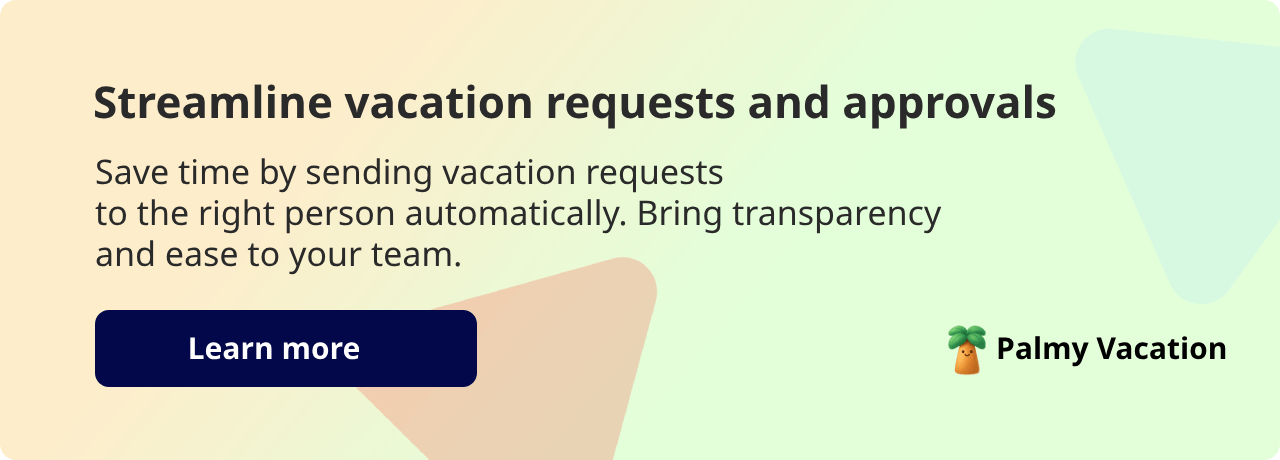How To Manage Vacation Requests As A Small Team
Spending too much time managing vacation requests? Here is how to streamline the process and save headaches.


Managing leave requests in a small team can feel like a scheduling nightmare at times. This is especially true when everyone wants time off during peak periods. How do you respond to this challenge when there aren’t enough people to keep things running smoothly?
Here at BuddiesHR, we’ve developed a plan just for small teams and show you how to manage paid time off with empathy, fairness, and proactivity.
Why managing vacation time is critical for small teams
When every team member plays a critical role, having one or two team members put in time off requests can cause chaos for everyone else. Here’s where the delicate balancing act between smooth operations and the well-being of your employees becomes the key to navigating this challenge. But it will take a partnership between you, your employees, and some smart solutions to make it happen.
Create a time off policy
If you don’t have an employee handbook for managing employee practices, this is where you can start. A fair and transparent policy document addressing employee time-off requests will go a long way toward handling future vacation requests. The company’s vacation policy serves as a guide for dealing with peak times, how you will prioritize requests, and how much vacation time each employee has.
As a general guideline, you can include the following:
- State vacation laws and holidays.
- Eligibility and accrual.
- Types of paid time off.
- Request and approval process.
- PTO payout and unused vacation days.
- Unlimited vacation policies (if offered).
- Legal compliance
We’ve compiled a template for small teams, and you’re welcome to use it. 👉Paid Time Off Policy Examples.
Communicating the policy to your team
Encourage employees to read the vacation policy and ask questions when they don’t understand how it works. This is important for managing employee time in a way that meets the needs of both your employees and your business.
Have a Slack Workspace?
Then consider putting the time off policy where you already spend all your time. This way, your team can easily access the document, and you can share updates quickly and easily with everyone. And why stop there?
By adding a Slack-first app like Palmy Vacation to your workspace, you can simply plug in your vacation rules and let Palmy manage the process for you.
Palmy will:
- Let your employees know how much paid time off they have.
- Enable the employee to quickly submit PTO requests within their Slack.
- Provide a way for managing time off requests with a one-click approval feature.
- Keep a log of everything, tracking previous requests and ensuring compliance with leave policies.
This is the ideal way to increase employee satisfaction. With a clear company policy, it is fair for the entire team because it doesn’t favor only certain employees. Your employees’ vacation requests are dealt with quickly and efficiently.
Using an Excel spreadsheet to manage time off requests
If you don’t use Slack as your main communication platform, and are looking for something really simple to manage requests for time off. No worries. A really small team can make do with an Excel spreadsheet. With some basic Excel knowledge, you can set up a template with different types of PTOs and give your employees access to it for leave requests.
We’re here to help wherever we can, and put together a short guide on how you can ‘Create an Create An Excel Template For Keeping Track Of PTOs’

Pros and cons of using Excel to request time off
Before you go to work on your Excel spreadsheet, it would be helpful to consider the pros and cons of using an Excel template for PTOs.
Juggling the moving parts of PTO requests in a small team
Juggling all the moving parts of vacation requests can seem like a whole job on its own. However, a little bit of knowledge will help you get your arms around it and create a smooth-flowing process for your team.
The submission of time off requests
The cardinal rule for dealing with time off requests is that it must be a simple system. If you live in Slack, it should be integrated into the platform. If you use an Excel template or Google Sheets template, it should be easily accessible on a shared drive. Furthermore, include the following in your request system:
1. Clear, required information
Each employee request should include:
- The employee’s name
- Type of leave (vacation, sick, personal, maternity, state holiday)
- Start and end dates
- Total number of days requested
- Balance of PTO (or total asked this year so far)
This standardization will allow managers to compare information quickly and notice patterns in leave requests.
A system that is still popular in many companies is a paper-based approval system. The staff member fills out a ‘vacation request form’ and then gives it to the manager for approval. The vacation days are then loaded onto the ERP by the HR person. This system has many pitfalls, and it’s advisable to move away from this system to one that can yield more accurate data and easier approvals (like Palmy Vacation).
2. Submission deadlines
Set rules for how far in advance a request should be submitted to allow for adequate planning. For example, vacation days should be approved two weeks in advance, and maternity or paternity leave two months before leave commencement. Encourage employees to stick to these deadlines by helping them to see how important it is to be proactive.
3. Acknowledgement of leave by the manager
Even if you don’t use a sophisticated automation system, employees should know that vacation requests must be ‘signed off’ or an acknowledgement given before it is considered valid. Problems arise with PTO requests when this is not made clear. Employees believe that a submitted vacation request equals approval, which is often not the case.
An automated system like Palmy Vacation streamlines this process and empowers employees in the Slack workspace to get their requests approved quickly. But it also plays a role in helping the manager make a decision, because it provides all the information needed to process the application.
4. Tracking of previous requests
Perhaps tracking previous requests doesn’t seem that important unless you’re part of the HR team, but that’s not true. Managers who have visibility of previous vacation requests can use the information to actively manage the time off of their team.
Patterns are important. If you have one employee who continually takes time off during peak seasons, this may indicate an unwillingness to work over those times, or perhaps an inability to handle high stress levels.
5. Tie vacation approvals to a shared calendar
Whether it’s Microsoft Outlook, Google Calendar, Palmy Vacation, or another shared platform, this step will save you a great deal of time, approval errors, and confusion. Doing this also holds other benefits, such as:
- Allowing employees to see when other team members are on vacation. This prevents multiple requests for leave on the same days. It also makes it easier to see who is around when meetings need to be scheduled or projects allocated.
- Providing a way for managers to schedule workload better and formulate plans to deal with gaps during peak seasons.
- Fostering trust and transparency, employees see that leave requests are approved according to company policies.
Managing overlapping vacation requests
This is where things can get tricky for both managers and team members. When you have two or more employees all requesting the same days off, what do you do? What you should do is have a consistent rule for dealing with the situation.
Here are three approaches you can use:
If you’re already using Slack, then add Palmy Vacation to help you manage multiple vacation requests.
Rewarding employees
One way of introducing a reward system around vacation requests, and thereby getting employee buy-in, is to reward employees who are flexible around high-demand periods and willing to fill in for their colleagues.
Time-off can be treated as a problem by managers as they struggle to balance the demands of their team, but acknowledging those who go the extra mile when they’re needed is a great way to keep everyone motivated.
Build in incentives, such as:
- Bonus days off for working during peak seasons or willingness to work on a rotating schedule.
- An extra day of vacation for standing in for other employees who need time off.
- Public recognition and half-days off for team members who are willing to swap out their vacation days with others.
Current best practices: Managing vacation requests for small teams
Finding out what others are doing can provide a helpful process for you to tailor to your own needs. So why start from scratch? Here are four examples of best practices for managing vacation requests for small teams.
1. Align PTO scheduling with workloads and project milestones
The first step is to map out major busy times, project deadlines, and seasonal peaks. Then use Palmy Vacation, a shared calendar, or a workboard platform like Miro to visually communicate these critical times to your staff members. Encourage the team to take vacations outside of these times, and request early vacation requests to be submitted, giving yourself plenty of time to be proactive with your planning.
Why this works for small teams:
In small teams, one person’s absence can lead to a critical delay in project completion or extra workload for other employees. By aligning PTO scheduling with workload, you have an opportunity to get ahead of any surprises.
2. Cross-train team members to cover for one another
By identifying overlapping skills and looking at extra capacity in certain roles, you can encourage employees to cover for one another during peak times. Document key processes with the help of video apps, like Loom, Vidyard, or Sendspark. With the help of these videos, you can upskill your team members and have a great reference library for how to get things done.
Why this works for small teams:
Cross-training makes managing PTOs easier for everyone. When you’re a small team, you can’t afford to have multiple team members off, but that seems a bit unfair to the team to deny them a well-deserved rest. Getting creative about it is the only way to go. When managers don’t have to compromise customer service or quality to give employees time off, the vacation request process is much smoother.
3. Encourage team members to take their vacation time
We know this statement seems contrary to everything we’ve been discussing, especially since we agree that small teams struggle to get this right. However, burnout and employee demotivation are no fun either.
Keeping team members fresh and plugged in will require a good balance between company results and the need for employees to get some rest and spend time doing things they feel are important.
Monitor unused time off, and gently nudge employees to take this time when things are quieter. Gamify approved leave requests by posting about it on Slack, and giving shout-outs when someone has agreed to take some vacation time. A simple, ‘Fred’s off to enjoy some well-deserved time with his family after a work run of 256 days! Enjoy it, Fred ⛱️.’ encourages a positive attitude around vacation times.
4. Integrate time off tools with your daily workflow
Make life very easy for yourself by integrating a PTO tool with your favorite communication platform. This way, you can automate the following:
- Vacation requests.
- PTO balance requests (a huge plus for HR!).
- Calendar updates.
- Vacation reminders.
- Unused vacation notifications.
- Previous PTO history, and amount of vacation time taken per cycle, quarter, or annually.
Successful implementation of vacation requests for small teams
That concludes our discussion on managing vacation requests for small teams. During our time together, we’ve shared everything in our bag of tricks to take vacation requests from nightmare to nirvana.
Our personal recommendation for small teams is to simplify your system as much as possible and look for ways to incorporate it into your current HR systems, or communication platform - don’t do extra work if you don’t have to.
With these simple tips and words of wisdom, you’ll be well on your way to a smooth, easy, fun, and rewarding vacation request process - and we want that for you, because we love small teams. In fact, we’re so crazy about small teams succeeding that we’ll give you the entire suite of BuddiesHR apps for free (10 users or less).





